Click the blue text to follow us

Research Background
Coronary heart disease (CHD) is one of the leading causes of death worldwide, resulting in millions of direct deaths each year and leading to numerous sequelae such as disability, cardiac enlargement, and arrhythmias. Therefore, early diagnosis and prevention of CHD are of great significance. Diagnostic methods for CHD, such as cardiac stress tests, dynamic electrocardiograms, and coronary computed tomography (CT) angiography, play an important role in clinical practice but often require large equipment or complex procedures, hindering timely detection and treatment of CHD. Thus, there is an urgent need for a simple, rapid, and accurate detection method. Human breath may become a new diagnostic source as it contains specific disease biomarkers. For example, some researchers have explored the correlation between breath ammonia concentration and blood urea, as well as the correlation between exhaled isoprene and blood cholesterol. Regarding CHD, ischemic damage to myocardial cells produces unique biomarkers that are released through respiration. This indicates that exhaled gases are very promising candidates for non-invasive diagnosis of CHD.
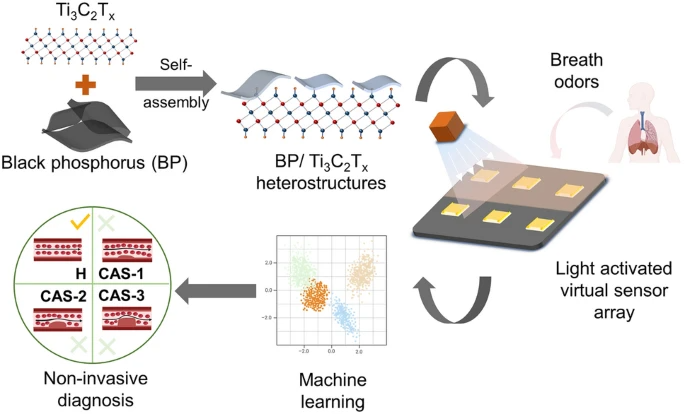 Light-Activated Virtual Sensor Array with Machine Learning for Non-Invasive Diagnosis of Coronary Heart DiseaseJiawang Hu, Hao Qian, Sanyang Han, Ping Zhang* & Yuan Lu*Nano-Micro Letters (2024)16: 274
Light-Activated Virtual Sensor Array with Machine Learning for Non-Invasive Diagnosis of Coronary Heart DiseaseJiawang Hu, Hao Qian, Sanyang Han, Ping Zhang* & Yuan Lu*Nano-Micro Letters (2024)16: 274
https://doi.org/10.1007/s40820-024-01481-7
Highlights of the Article
1. Synthesis of light-responsive BP/Ti₃C₂Tₓ composites through self-assembly strategy.
2. Achieved enhanced gas sensitivity through visible light modulation.
3. Constructed a light-activated virtual sensor array based on BP/Ti₃C₂Tₓ composites.
4. Achieved non-invasive diagnosis of coronary heart disease through breath samples with the help of machine learning.
Content Summary
Early non-invasive diagnosis of coronary heart disease (CHD) is crucial. However, achieving accurate CHD diagnosis through human breath detection is a challenge. In this work, Yuan Lu, Ping Zhang, and others from Tsinghua University prepared a heterostructure composite of black phosphorus (BP) and two-dimensional carbide (MXene) with high gas sensitivity and light responsiveness using a self-assembly strategy. A light-activated virtual sensor array (LAVSA) based on BP/Ti₃C₂Tₓ was prepared under light modulation and further assembled into an instant gas sensing platform (IGSP). Additionally, machine learning (ML) algorithms were introduced to assist the IGSP in detecting and identifying breath sample signals to diagnose CHD. Besides the light excitation effect, the synthesized heterostructure composite exhibited higher performance than pure Ti₃C₂Tₓ due to the synergistic effect of BP and Ti₃C₂Tₓ, with a response value 26% higher than that of pure Ti₃C₂Tₓ. Furthermore, with the help of pattern recognition algorithms, LAVSA successfully detected and identified 15 types of odor molecules including alcohols, ketones, aldehydes, esters, and acids. Meanwhile, with the assistance of ML, the IGSP achieved an accuracy of 69.2% in detecting breath odors from 45 volunteers, including healthy individuals and CHD patients. In summary, this work designed and manufactured an instant, low-cost, and accurate prototype for non-invasive diagnosis of coronary heart disease, providing a universal solution for diagnosing other diseases and more complex application scenarios.
Illustrated Guide
I Preparation and Characterization of BP/Ti₃C₂Tₓ Gas Sensors
To study the surface morphology of the materials, scanning electron microscopy (SEM), transmission electron microscopy (TEM), and atomic force microscopy (AFM) were used to observe the samples. The nanosheets of Ti₃C₂Tₓ appeared as uniform thin layers in the TEM images, reflecting a typical two-dimensional structure. The thickness of the Ti₃C₂Tₓ nanosheets was shown to be about 3 nm in the AFM images, consistent with the TEM results. The TEM images of BP also displayed a stacked flake structure, indicating the two-dimensional material characteristics of BP. In the AFM images, the thickness of BP nanosheets was approximately 30 nm and uniformly distributed. The TEM images of the BP/Ti₃C₂Tₓ heterostructure showed the self-assembled morphology of BP nanosheets on the surface of Ti₃C₂Tₓ. To further investigate the BP/Ti₃C₂Tₓ heterostructure, high-resolution transmission electron microscopy (HRTEM) was employed to observe the crystalline characteristics. The HRTEM images indicated the presence of two distinctly different lattice spacing widths of 0.27 and 0.34 nm, corresponding to the (002) plane of Ti₃C₂Tₓ and the (020) plane of BP. The corresponding selected area electron diffraction (SAED) patterns showed bright spots consistent with the lattice spacings, indicating that the BP/Ti₃C₂Tₓ heterostructure exhibited typical crystalline characteristics. The samples’ elemental distribution and film formation morphology were examined through SEM and energy-dispersive spectroscopy (EDS). The SEM images of pure Ti₃C₂Tₓ showed a uniform thin film formation, indicating successful preparation of Ti₃C₂Tₓ nanosheets, and the uniform distribution of Ti, O, and C elements can be seen through EDS elemental mapping. The SEM images of BP showed successful preparation of BP nanosheets, with a uniform distribution of P visible through EDS elemental mapping. The SEM images of the composite material displayed a stacked film structure, proving that BP self-assembled to form a nanocomposite structure on Ti₃C₂Tₓ. EDS elemental mapping confirmed the distribution of elements C, O, P, and Ti in BP/Ti₃C₂Tₓ. In summary, the surface morphology and elemental distribution based on BP and Ti₃C₂Tₓ indicate successful self-assembly of the heterostructure.
X-ray diffraction (XRD) analysis was conducted to determine the crystal structure and phase composition. The characteristic diffraction peaks of BP were located at 2θ = 17.5° and 34.9°, corresponding to the (020) and (040) crystal planes, respectively. Ti₃C₂Tₓ exhibited a prominent peak at approximately 7.1°, corresponding to the (002) crystal plane. The heterostructure of BP/Ti₃C₂Tₓ was primarily confirmed by observing whether the diffraction peaks of BP and Ti₃C₂Tₓ were present simultaneously. As BP self-assembled onto the surface of Ti₃C₂Tₓ, the peak intensity of Ti₃C₂Tₓ gradually decreased. This is because X-rays need to penetrate the BP nanosheets to reach the Ti₃C₂Tₓ layer, resulting in a reduction of the peak intensity of Ti₃C₂Tₓ. The simultaneous appearance of characteristic peaks of BP and Ti₃C₂Tₓ in the XRD spectrum confirms that BP/Ti₃C₂Tₓ possesses a good crystalline structure.
X-ray photoelectron spectroscopy (XPS) analysis was performed to study the surface chemical composition and bonding states of BP/Ti₃C₂Tₓ. The wide spectrum showed the presence of Ti, C, P, O, F, and N elements in BP/Ti₃C₂Tₓ. The high-resolution C 1s spectrum displayed three peaks at 281.21, 284.53, and 286.47 eV, corresponding to C-Ti-O, C-C, and C-O, respectively. The high-resolution O 1s spectrum showed two strong peaks at 529.95 and 532.27 eV, corresponding to C-Ti-O and Ti-O-P, respectively. The high-resolution P 2p spectrum showed strong peaks at 129.72 and 130.83 eV corresponding to P 2p3/2 and P 2p1/2, as well as a peak corresponding to PxOy at 134.12 eV. The high-resolution Ti 2p spectrum displayed two double peaks with an area ratio of 1:2, namely Ti 2p1/2 and Ti 2p3/2. The two strong peaks of Ti 2p3/2 were observed at 455.32 and 456.51 eV, corresponding to Ti-C and Ti-Tₓ. This indicates that the main chemical states of Ti in Ti₃C₂Tₓ, Ti-C, and Ti-Tₓ are not oxidized. In summary, the XPS analysis revealed important information regarding the chemical composition and bonding states of the BP/Ti₃C₂Tₓ heterostructure, providing evidence for the successful preparation of the composite.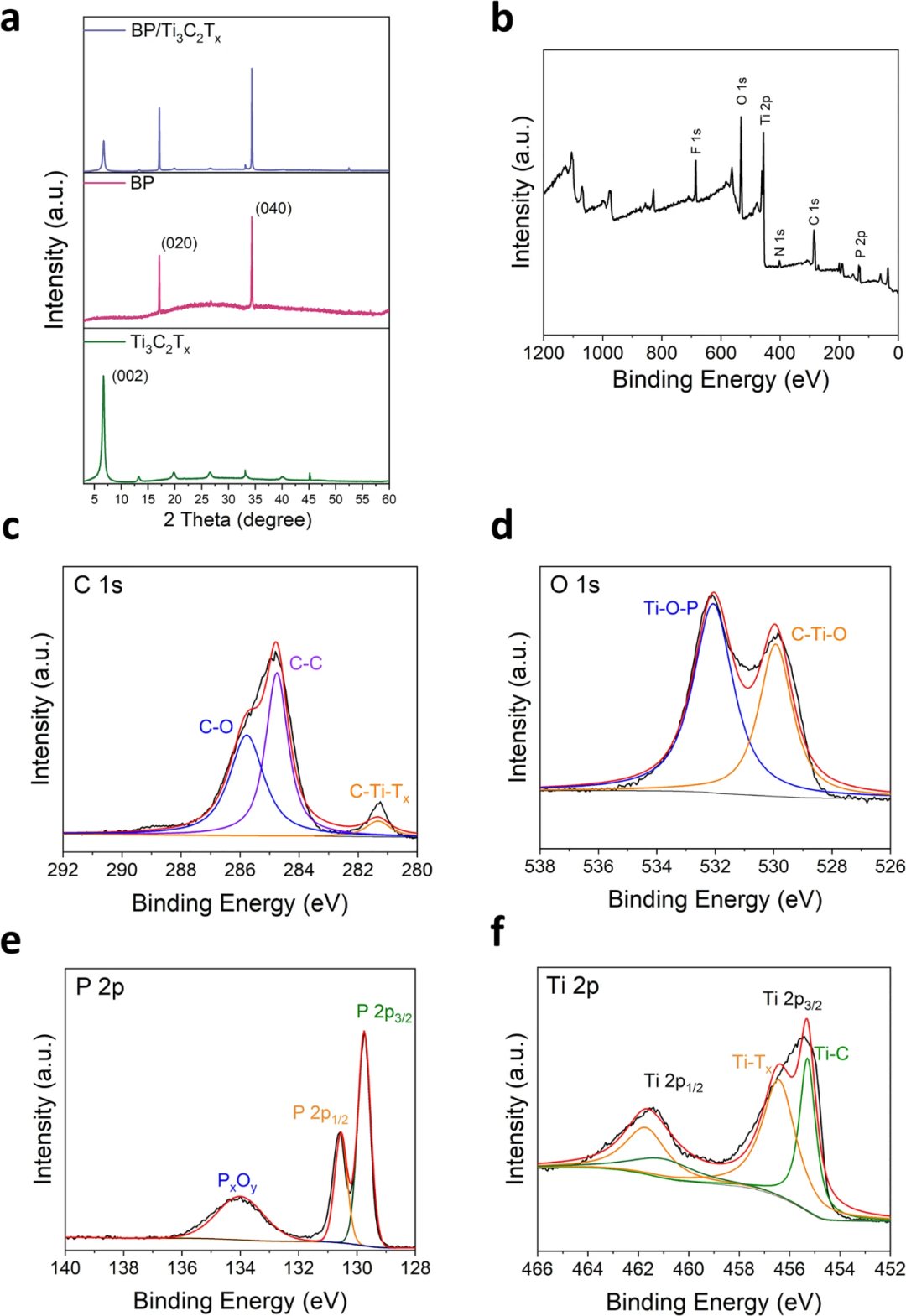 Figure 1. Physical, microscopic, and crystalline structure of BP/Ti₃C₂Tₓ gas sensors
Figure 1. Physical, microscopic, and crystalline structure of BP/Ti₃C₂Tₓ gas sensors 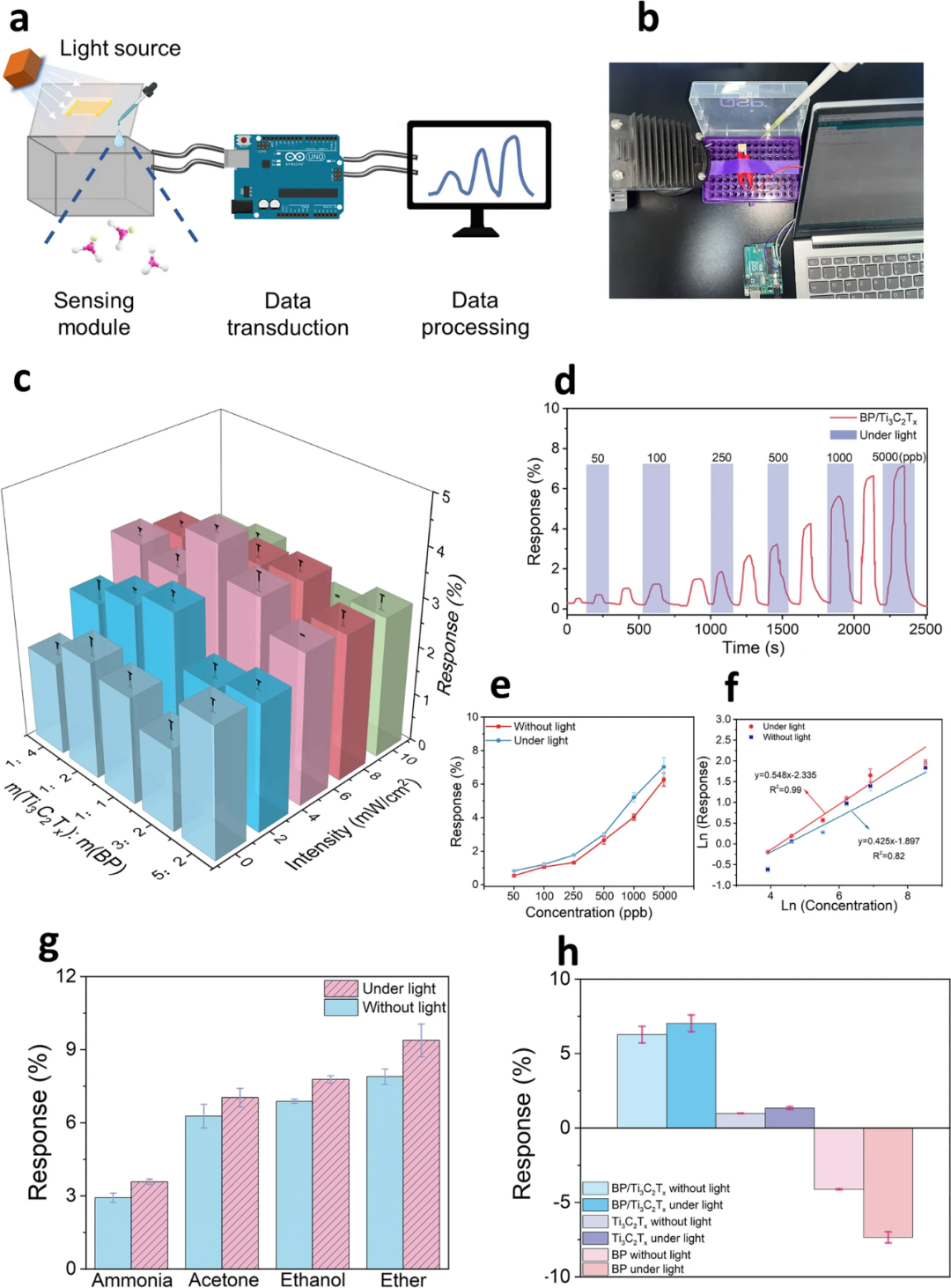 Figure 2. Characterization of the crystalline and chemical properties of BP/Ti₃C₂Tₓ gas sensorsII Sensing Characteristics of BP/Ti₃C₂Tₓ Gas SensorsFirst, the optimal ratio between BP and Ti₃C₂Tₓ, as well as the best light wavelength and intensity, were explored using acetone for testing. According to previous reports, since the light absorption ranges of A and B are between visible light and near-infrared, representative wavelengths of 420 and 800 nm were selected for the study. It can be seen that the sensor response is different at the wavelengths of 420 nm and 800 nm, with the sensor exhibiting a higher response at 420 nm. Furthermore, as the BP content increases, the sensor response shows a convex function property, with the highest response at a mass ratio of 1:1. Additionally, as the light intensity gradually increases, the sensor response also exhibits a convex function property, with the highest response at a light intensity of 5 mW/cm². In summary, the optimal response of the sensor occurs at a light wavelength of 420 nm, an intensity of 5 mW/cm², and a mass ratio of BP to Ti₃C₂Tₓ of 1:1.To compare the effect of light on the response, BP/Ti₃C₂Tₓ was tested under light and dark conditions for gas concentrations ranging from 50 ppb to 5 ppm. The change in resistance of BP/Ti₃C₂Tₓ was higher under light conditions than in the absence of light, as light facilitated the electronic exchange of gas molecules on the surface of BP/Ti₃C₂Tₓ. In both light and dark target gas environments, the resistance of the sensor increased. This may be attributed to the adsorption of gas molecules by the surface groups of BP/Ti₃C₂Tₓ, causing a decrease in the concentration of hole carriers within BP/Ti₃C₂Tₓ. Notably, at 5 ppm, the response values of BP/Ti₃C₂Tₓ under light for acetone, ammonia, ether, and ethanol were 7.21%, 3.67%, 9.32%, and 7.55%, respectively, which are 1.19, 1.22, 1.26, and 1.07 times the responses without light. This may be due to the photon activation of surface electrons in BP/Ti₃C₂Tₓ, promoting the adsorption of gas molecules onto the material’s surface, thereby reducing the carrier density in Ti₃C₂Tₓ and enhancing sensitivity. As the gas concentration increases, the number of carriers decreases, leading to an increase in channel resistance and thus an increase in sensor resistance.Compared to reported light-activated gas sensors, BP/Ti₃C₂Tₓ gas sensors exhibited significant responses to target gases and demonstrated excellent gas sensitivity performance. Furthermore, to visualize the relationship between target gas concentration and sensor response, the natural logarithm of the response values of BP/Ti₃C₂Tₓ under light and dark conditions was linearly fitted against the natural logarithm of gas concentration. For acetone and ether, the slope under light was greater than that in the absence of light as gas concentration increased. In contrast, the slopes for ammonia and ethanol were smaller under light than in the absence of light. The results indicate that the BP/Ti₃C₂Tₓ sensor is more sensitive to acetone and ether gases under light, likely due to the stronger adsorption capacity of BP/Ti₃C₂Tₓ in the presence of light. Notably, the BP/Ti₃C₂Tₓ-based sensor demonstrated good linearity for these gases over a concentration range of 50 ppb to 5 ppm, indicating that the sensor can be further applied for real-time monitoring and concentration measurement across a 100-fold concentration range.To compare the selectivity of BP/Ti₃C₂Tₓ under light and dark conditions, each of the aforementioned four gases was tested at a concentration of 5 ppm. Under light conditions, the response differences among different gases increased, indicating improved gas selectivity. Additionally, to compare the effect of light on the gas sensitivity of Ti₃C₂Tₓ, BP, and BP/Ti₃C₂Tₓ composites, the four gases were tested under light conditions at 5 ppm. The three materials exhibited responses of 1.13%, -4.03%, and 6.06% in the absence of light, respectively. Under light conditions, the corresponding responses increased by 1.07, 1.76, and 1.19 times, indicating that light enhances the response differences among the sensors, thus providing greater selectivity.
Figure 2. Characterization of the crystalline and chemical properties of BP/Ti₃C₂Tₓ gas sensorsII Sensing Characteristics of BP/Ti₃C₂Tₓ Gas SensorsFirst, the optimal ratio between BP and Ti₃C₂Tₓ, as well as the best light wavelength and intensity, were explored using acetone for testing. According to previous reports, since the light absorption ranges of A and B are between visible light and near-infrared, representative wavelengths of 420 and 800 nm were selected for the study. It can be seen that the sensor response is different at the wavelengths of 420 nm and 800 nm, with the sensor exhibiting a higher response at 420 nm. Furthermore, as the BP content increases, the sensor response shows a convex function property, with the highest response at a mass ratio of 1:1. Additionally, as the light intensity gradually increases, the sensor response also exhibits a convex function property, with the highest response at a light intensity of 5 mW/cm². In summary, the optimal response of the sensor occurs at a light wavelength of 420 nm, an intensity of 5 mW/cm², and a mass ratio of BP to Ti₃C₂Tₓ of 1:1.To compare the effect of light on the response, BP/Ti₃C₂Tₓ was tested under light and dark conditions for gas concentrations ranging from 50 ppb to 5 ppm. The change in resistance of BP/Ti₃C₂Tₓ was higher under light conditions than in the absence of light, as light facilitated the electronic exchange of gas molecules on the surface of BP/Ti₃C₂Tₓ. In both light and dark target gas environments, the resistance of the sensor increased. This may be attributed to the adsorption of gas molecules by the surface groups of BP/Ti₃C₂Tₓ, causing a decrease in the concentration of hole carriers within BP/Ti₃C₂Tₓ. Notably, at 5 ppm, the response values of BP/Ti₃C₂Tₓ under light for acetone, ammonia, ether, and ethanol were 7.21%, 3.67%, 9.32%, and 7.55%, respectively, which are 1.19, 1.22, 1.26, and 1.07 times the responses without light. This may be due to the photon activation of surface electrons in BP/Ti₃C₂Tₓ, promoting the adsorption of gas molecules onto the material’s surface, thereby reducing the carrier density in Ti₃C₂Tₓ and enhancing sensitivity. As the gas concentration increases, the number of carriers decreases, leading to an increase in channel resistance and thus an increase in sensor resistance.Compared to reported light-activated gas sensors, BP/Ti₃C₂Tₓ gas sensors exhibited significant responses to target gases and demonstrated excellent gas sensitivity performance. Furthermore, to visualize the relationship between target gas concentration and sensor response, the natural logarithm of the response values of BP/Ti₃C₂Tₓ under light and dark conditions was linearly fitted against the natural logarithm of gas concentration. For acetone and ether, the slope under light was greater than that in the absence of light as gas concentration increased. In contrast, the slopes for ammonia and ethanol were smaller under light than in the absence of light. The results indicate that the BP/Ti₃C₂Tₓ sensor is more sensitive to acetone and ether gases under light, likely due to the stronger adsorption capacity of BP/Ti₃C₂Tₓ in the presence of light. Notably, the BP/Ti₃C₂Tₓ-based sensor demonstrated good linearity for these gases over a concentration range of 50 ppb to 5 ppm, indicating that the sensor can be further applied for real-time monitoring and concentration measurement across a 100-fold concentration range.To compare the selectivity of BP/Ti₃C₂Tₓ under light and dark conditions, each of the aforementioned four gases was tested at a concentration of 5 ppm. Under light conditions, the response differences among different gases increased, indicating improved gas selectivity. Additionally, to compare the effect of light on the gas sensitivity of Ti₃C₂Tₓ, BP, and BP/Ti₃C₂Tₓ composites, the four gases were tested under light conditions at 5 ppm. The three materials exhibited responses of 1.13%, -4.03%, and 6.06% in the absence of light, respectively. Under light conditions, the corresponding responses increased by 1.07, 1.76, and 1.19 times, indicating that light enhances the response differences among the sensors, thus providing greater selectivity.  Figure 3. Structure of IGSP and sensing performance of BP/Ti₃C₂Tₓ gas sensorsIII Sensing Characteristics of LAVSAPrevious studies on gas sensor arrays (SA) typically required testing a large number of different materials to obtain a single sensor with unique performance, and the marginal benefits decrease as the number of sensors increases. Ti₃C₂Tₓ, BP, and BP/Ti₃C₂Tₓ exhibit significant differences in gas response, and light modulation can enhance these differences. In this work, inspired by the light modulation strategy, if an SA made from these three materials detects gases under light and dark conditions, it allows for double the gas sensing data, effectively doubling the dimensions of the sensors. The initial SA consisted of three individual sensors, and under light modulation, it was equivalent to introducing three virtual sensors to prepare LAVSA. This not only simplifies the preparation process of the SA but also maintains good performance. The LAVSA manufactured in this work consists of six sensors, including Sensor 1: (dark) BP/Ti₃C₂Tₓ, Sensor 2: (light) BP/Ti₃C₂Tₓ, Sensor 3: (dark) Ti₃C₂Tₓ, Sensor 4: (light) Ti₃C₂Tₓ, Sensor 5: (dark) BP, and Sensor 6: (light) BP.First, the sensitivity performance of LAVSA was tested by exposing it to target gas environments ranging from 50 ppb to 5 ppm. After data collection, pattern recognition algorithms were used to distinguish and identify different gases. The response of each sensor increased with the concentration of the target gas. Due to the different compositions of the sensors, their responses to gases varied. For example, for 5 ppm of ammonia, the response of the sensor (light) BP/Ti₃C₂Tₓ was 3.67%, while the response of the sensor (light) BP was -11.03%. This difference can be used to demonstrate the selectivity of LAVSA. Each of the aforementioned four gases was subjected to multiple experiments at a concentration of 5 ppm, and principal component analysis (PCA) was used to analyze the data. Various gases clustered in their respective areas, indicating that LAVSA can distinguish these gases at a concentration of 5 ppm, thus demonstrating excellent selectivity. This is primarily attributed to the selective accumulation of the six sensors in LAVSA, which maximizes the differentiation of various gases by characterizing them across six dimensions. This indicates the successful manufacturing of LAVSA and demonstrates its significant effectiveness in selectively identifying target gases under light modulation, composed of individual sensors prepared with different ratios of BP and Ti₃C₂Tₓ.To test the practical performance of LAVSA, 15 odor molecules were introduced and tested, selecting five categories of substances: alcohols, ketones, aldehydes, esters, and acids. These molecules are widely present in nature and are typical. LAVSA was exposed to 15 different gases, ranging from 50 ppb to 5 ppm, to monitor its performance. Each sensor exhibited different average performance values for each gas, demonstrating the selective performance of LAVSA. Subsequently, each of these gases at a concentration of 5 ppm was subjected to multiple experiments, and the obtained data were analyzed with the help of PCA. Due to the significant differences in functional groups among these five categories of odor molecules, it can be observed that each category of gas molecules clustered in their respective areas, exhibiting good clustering characteristics, indicating that LAVSA can classify these five categories of gas molecules with the assistance of PCA.Additionally, a new algorithm, t-distributed stochastic neighbor embedding (t-SNE), was introduced to distinguish these 15 gas molecules. After extracting features and reducing dimensions from the sensor data, the values of the t-SNE graph axes represent the differences in characteristics of different gases. These 15 gases clustered separately, allowing for clear differentiation. The results indicate that with the assistance of t-SNE and PCA algorithms, LAVSA exhibits excellent sensitivity and selectivity, capable of accurately identifying five odor molecules and 15 specific gases. In summary, testing of the 15 odor molecules demonstrates that the LAVSA composed of BP and Ti₃C₂Tₓ possesses outstanding sensitivity and selectivity, with the potential for further practical applications.
Figure 3. Structure of IGSP and sensing performance of BP/Ti₃C₂Tₓ gas sensorsIII Sensing Characteristics of LAVSAPrevious studies on gas sensor arrays (SA) typically required testing a large number of different materials to obtain a single sensor with unique performance, and the marginal benefits decrease as the number of sensors increases. Ti₃C₂Tₓ, BP, and BP/Ti₃C₂Tₓ exhibit significant differences in gas response, and light modulation can enhance these differences. In this work, inspired by the light modulation strategy, if an SA made from these three materials detects gases under light and dark conditions, it allows for double the gas sensing data, effectively doubling the dimensions of the sensors. The initial SA consisted of three individual sensors, and under light modulation, it was equivalent to introducing three virtual sensors to prepare LAVSA. This not only simplifies the preparation process of the SA but also maintains good performance. The LAVSA manufactured in this work consists of six sensors, including Sensor 1: (dark) BP/Ti₃C₂Tₓ, Sensor 2: (light) BP/Ti₃C₂Tₓ, Sensor 3: (dark) Ti₃C₂Tₓ, Sensor 4: (light) Ti₃C₂Tₓ, Sensor 5: (dark) BP, and Sensor 6: (light) BP.First, the sensitivity performance of LAVSA was tested by exposing it to target gas environments ranging from 50 ppb to 5 ppm. After data collection, pattern recognition algorithms were used to distinguish and identify different gases. The response of each sensor increased with the concentration of the target gas. Due to the different compositions of the sensors, their responses to gases varied. For example, for 5 ppm of ammonia, the response of the sensor (light) BP/Ti₃C₂Tₓ was 3.67%, while the response of the sensor (light) BP was -11.03%. This difference can be used to demonstrate the selectivity of LAVSA. Each of the aforementioned four gases was subjected to multiple experiments at a concentration of 5 ppm, and principal component analysis (PCA) was used to analyze the data. Various gases clustered in their respective areas, indicating that LAVSA can distinguish these gases at a concentration of 5 ppm, thus demonstrating excellent selectivity. This is primarily attributed to the selective accumulation of the six sensors in LAVSA, which maximizes the differentiation of various gases by characterizing them across six dimensions. This indicates the successful manufacturing of LAVSA and demonstrates its significant effectiveness in selectively identifying target gases under light modulation, composed of individual sensors prepared with different ratios of BP and Ti₃C₂Tₓ.To test the practical performance of LAVSA, 15 odor molecules were introduced and tested, selecting five categories of substances: alcohols, ketones, aldehydes, esters, and acids. These molecules are widely present in nature and are typical. LAVSA was exposed to 15 different gases, ranging from 50 ppb to 5 ppm, to monitor its performance. Each sensor exhibited different average performance values for each gas, demonstrating the selective performance of LAVSA. Subsequently, each of these gases at a concentration of 5 ppm was subjected to multiple experiments, and the obtained data were analyzed with the help of PCA. Due to the significant differences in functional groups among these five categories of odor molecules, it can be observed that each category of gas molecules clustered in their respective areas, exhibiting good clustering characteristics, indicating that LAVSA can classify these five categories of gas molecules with the assistance of PCA.Additionally, a new algorithm, t-distributed stochastic neighbor embedding (t-SNE), was introduced to distinguish these 15 gas molecules. After extracting features and reducing dimensions from the sensor data, the values of the t-SNE graph axes represent the differences in characteristics of different gases. These 15 gases clustered separately, allowing for clear differentiation. The results indicate that with the assistance of t-SNE and PCA algorithms, LAVSA exhibits excellent sensitivity and selectivity, capable of accurately identifying five odor molecules and 15 specific gases. In summary, testing of the 15 odor molecules demonstrates that the LAVSA composed of BP and Ti₃C₂Tₓ possesses outstanding sensitivity and selectivity, with the potential for further practical applications. 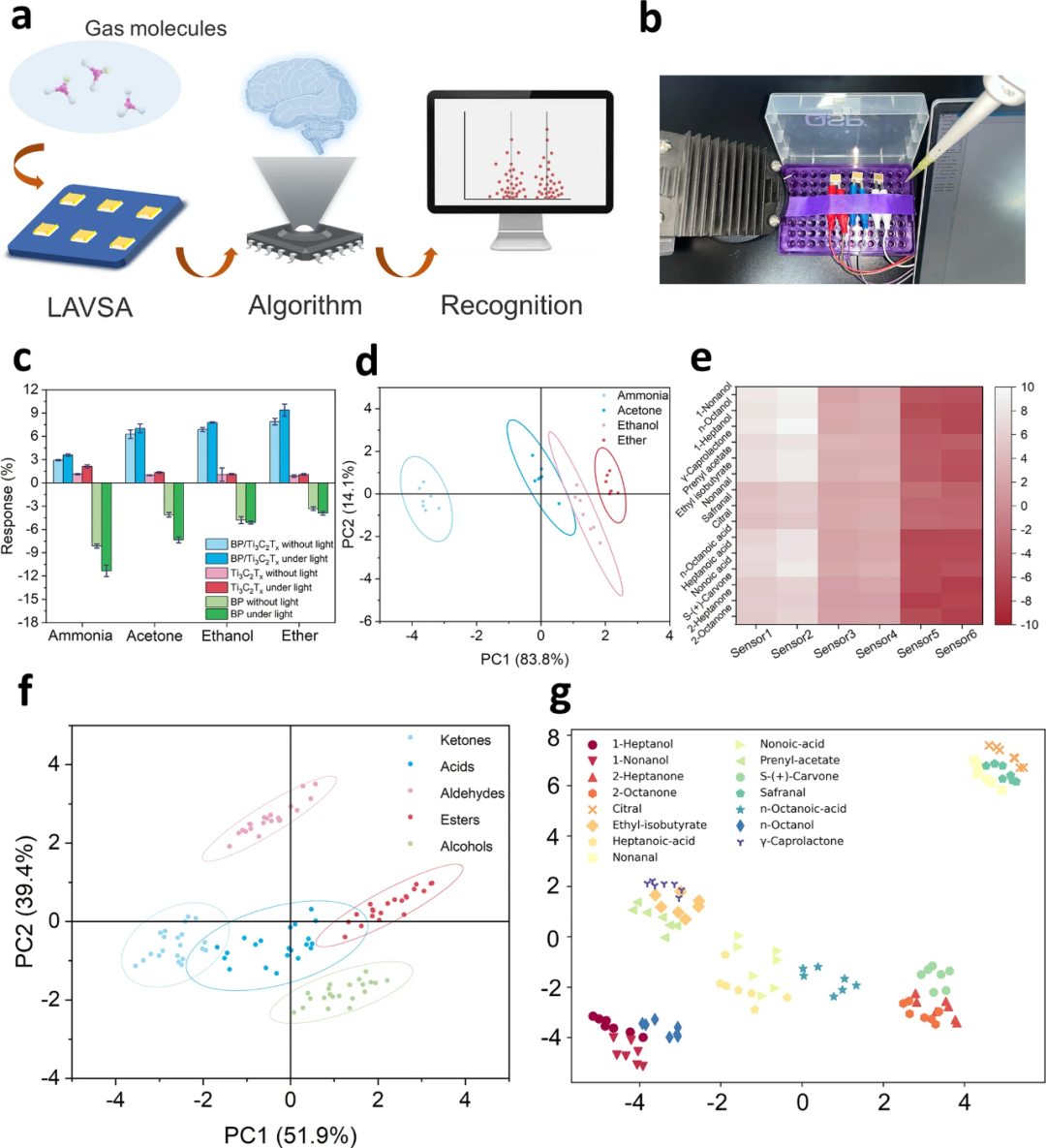 Figure 4. Gas sensing performance of LAVSAIV Identification of CHD Patients Based on IGSPThe diagnostic criteria for coronary heart disease typically involve the degree of coronary artery stenosis (CAS), where 0-25% is considered mild, 25-50% moderate, and greater than 50% severe. When the degree of CAS exceeds 50%, CHD can be diagnosed. The experimental design included 45 participants, comprising 10 healthy individuals (H), 11 mild (CAS-1) patients, 9 moderate (CAS-2) patients, and 15 severe (CAS-3) patients.The complexity of the breath gas odor components of patients with different degrees of CAS compared to healthy individuals, as well as the differences in breath gas odor components, form the basis for identification and classification. Gas chromatography-mass spectrometry (GC-MS) was used to determine the differences in breath gas odor components among different groups of H, CAS-1, CAS-2, and CAS-3 samples. The GC-MS results showed some differences in the odors exhaled by different categories of individuals. Analysis and further summarization revealed that the H samples contained components such as ethyl acetate, acetone, and 2-ethyl-1-hexanol. The CAS-1 samples contained components such as 2,2,4-trimethyl-1,3-pentanediol diisobutyrate, acetone, and ethyl acetate. The CAS-2 samples contained components such as 2-ethyl-1-hexanol, acetone, and ethyl acetate. The CAS-3 samples contained components such as acetone, ethyl acetate, and ethanol. The diversity of components indicates that the biomarkers contained in different types of samples are clearly identifiable.To detect and identify gas samples through IGSP, machine learning (ML) algorithms were employed to assist in achieving this goal. First, the data must be organized into a size of 20 × 45, and then further classified into four labels based on the four categories. These data were then used for algorithm training and optimization. Histograms and box plots displayed the distribution of gas sensing performance among the various sensors in LAVSA, showing the diversity of responses to various types of gas samples. The mathematical relationships between the sensors were displayed in a scatter matrix plot, indicating significant differences between the signals. Six ML algorithms were employed for data processing, namely logistic regression (LR), linear discriminant analysis (LDA), k-nearest neighbors (KNN), classification and regression trees (CART), naive Bayes model (NB), and support vector machine (SVM). From the confusion matrix, it can be seen that the prediction accuracy for the four categories of participants from different populations was 77% for H, 71% for CAS-1, 58% for CAS-2, and 84% for CAS-3. The predictive results of the six algorithms through 10-fold cross-validation tests showed that CART performed the best, with an accuracy of 0.692, indicating good performance in identifying breath odors. In contrast, LR had an accuracy of 0.403, demonstrating its unsuitability for inter-sample identification. However, the IGSP has some limitations, such as requiring known calibration samples for accurate detection, necessitating a large calibration sample library, and the detection of gas categories remains an unresolved issue. Furthermore, determining the composition and corresponding concentration of exhaled gases through IGSP remains challenging.
Figure 4. Gas sensing performance of LAVSAIV Identification of CHD Patients Based on IGSPThe diagnostic criteria for coronary heart disease typically involve the degree of coronary artery stenosis (CAS), where 0-25% is considered mild, 25-50% moderate, and greater than 50% severe. When the degree of CAS exceeds 50%, CHD can be diagnosed. The experimental design included 45 participants, comprising 10 healthy individuals (H), 11 mild (CAS-1) patients, 9 moderate (CAS-2) patients, and 15 severe (CAS-3) patients.The complexity of the breath gas odor components of patients with different degrees of CAS compared to healthy individuals, as well as the differences in breath gas odor components, form the basis for identification and classification. Gas chromatography-mass spectrometry (GC-MS) was used to determine the differences in breath gas odor components among different groups of H, CAS-1, CAS-2, and CAS-3 samples. The GC-MS results showed some differences in the odors exhaled by different categories of individuals. Analysis and further summarization revealed that the H samples contained components such as ethyl acetate, acetone, and 2-ethyl-1-hexanol. The CAS-1 samples contained components such as 2,2,4-trimethyl-1,3-pentanediol diisobutyrate, acetone, and ethyl acetate. The CAS-2 samples contained components such as 2-ethyl-1-hexanol, acetone, and ethyl acetate. The CAS-3 samples contained components such as acetone, ethyl acetate, and ethanol. The diversity of components indicates that the biomarkers contained in different types of samples are clearly identifiable.To detect and identify gas samples through IGSP, machine learning (ML) algorithms were employed to assist in achieving this goal. First, the data must be organized into a size of 20 × 45, and then further classified into four labels based on the four categories. These data were then used for algorithm training and optimization. Histograms and box plots displayed the distribution of gas sensing performance among the various sensors in LAVSA, showing the diversity of responses to various types of gas samples. The mathematical relationships between the sensors were displayed in a scatter matrix plot, indicating significant differences between the signals. Six ML algorithms were employed for data processing, namely logistic regression (LR), linear discriminant analysis (LDA), k-nearest neighbors (KNN), classification and regression trees (CART), naive Bayes model (NB), and support vector machine (SVM). From the confusion matrix, it can be seen that the prediction accuracy for the four categories of participants from different populations was 77% for H, 71% for CAS-1, 58% for CAS-2, and 84% for CAS-3. The predictive results of the six algorithms through 10-fold cross-validation tests showed that CART performed the best, with an accuracy of 0.692, indicating good performance in identifying breath odors. In contrast, LR had an accuracy of 0.403, demonstrating its unsuitability for inter-sample identification. However, the IGSP has some limitations, such as requiring known calibration samples for accurate detection, necessitating a large calibration sample library, and the detection of gas categories remains an unresolved issue. Furthermore, determining the composition and corresponding concentration of exhaled gases through IGSP remains challenging. 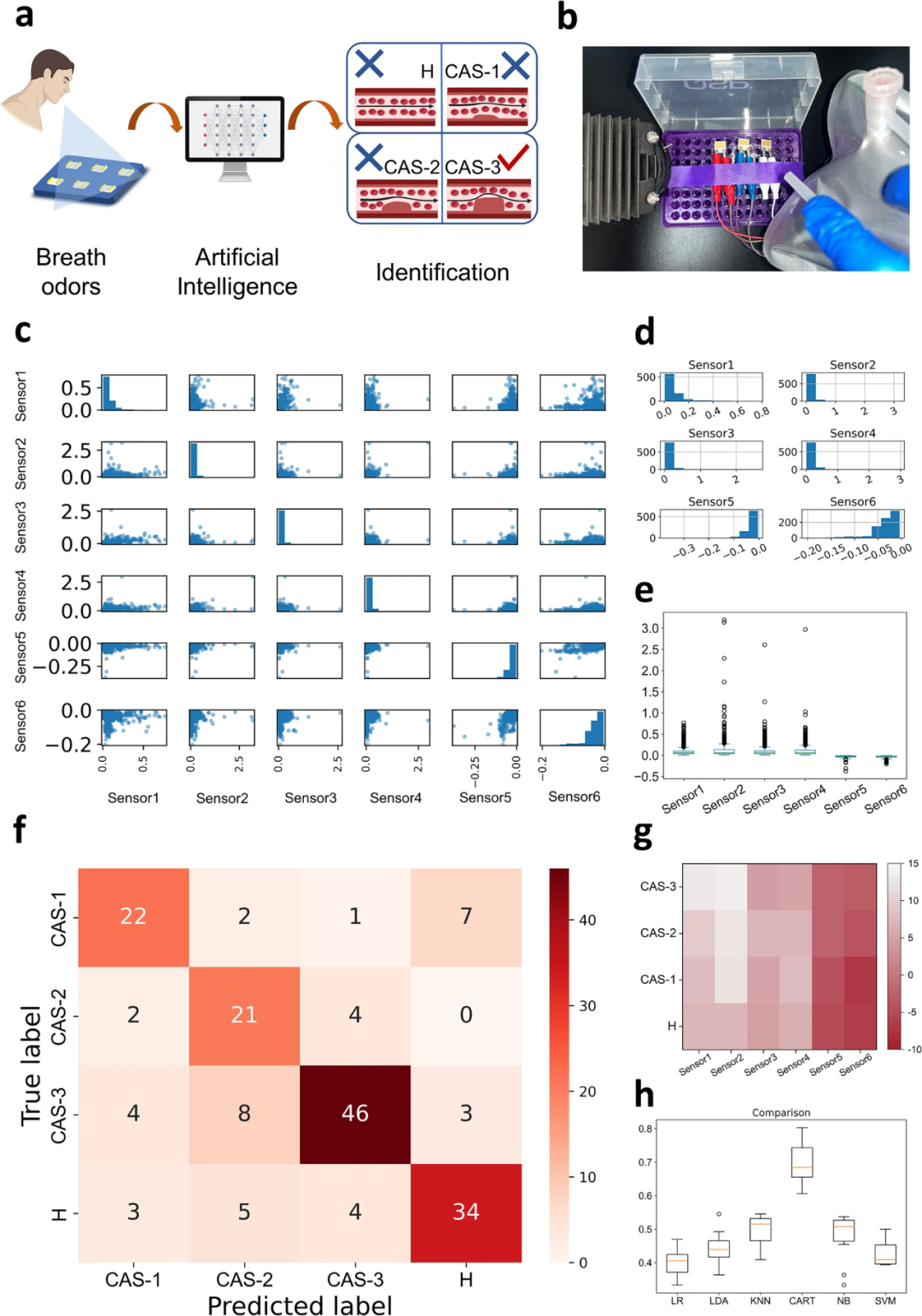 Figure 5. Results of identifying CHD through breath odorsV IGSP Sensing MechanismThe gas sensitivity characteristics of BP/Ti₃C₂Tₓ are enhanced under visible light irradiation compared to pure Ti₃C₂Tₓ. This is primarily due to the synergistic effect between BP and Ti₃C₂Tₓ, as well as the increased electronic exchange due to photon activation. On one hand, the self-growth of BP nanosheets can lead to a higher specific surface area and active sites, thereby enhancing the gas adsorption and desorption processes. On the other hand, the heterostructure formed by BP and Ti₃C₂Tₓ, along with the modulation of carrier density through photon excitation, is a crucial factor in improving the gas sensitivity performance of the sensor. According to the literature, the conduction band (CB) potential and valence band (VB) potential of BP are 0.83 eV and 1.17 eV, respectively. Under visible light irradiation, photo-excited electrons transfer from the VB to the CB of BP. Due to the lower Fermi level (EF) of Ti₃C₂Tₓ at -0.17 eV, electrons will further transfer to Ti₃C₂Tₓ. Since the EF of Ti₃C₂Tₓ is more negative than the potential of O₂/·O₂⁻ at 0.046 eV, and Ti₃C₂Tₓ has excellent conductivity (4600 ± 1100 S cm⁻¹), the generated photoelectrons rapidly transfer to the surface of Ti₃C₂Tₓ and are ultimately captured by O₂. Gas molecules such as VOCs absorb electrons from ·O₂⁻ on the surface of Ti₃C₂Tₓ, generating CO₂ and H₂O. Therefore, the electronic exchange between the target gas and the surface of BP/Ti₃C₂Tₓ is enhanced through the aforementioned process. In summary, the enhanced gas sensitivity performance is attributed to the formation of heterostructures, the increase in active sites, and the modulation of carrier density through light.
Figure 5. Results of identifying CHD through breath odorsV IGSP Sensing MechanismThe gas sensitivity characteristics of BP/Ti₃C₂Tₓ are enhanced under visible light irradiation compared to pure Ti₃C₂Tₓ. This is primarily due to the synergistic effect between BP and Ti₃C₂Tₓ, as well as the increased electronic exchange due to photon activation. On one hand, the self-growth of BP nanosheets can lead to a higher specific surface area and active sites, thereby enhancing the gas adsorption and desorption processes. On the other hand, the heterostructure formed by BP and Ti₃C₂Tₓ, along with the modulation of carrier density through photon excitation, is a crucial factor in improving the gas sensitivity performance of the sensor. According to the literature, the conduction band (CB) potential and valence band (VB) potential of BP are 0.83 eV and 1.17 eV, respectively. Under visible light irradiation, photo-excited electrons transfer from the VB to the CB of BP. Due to the lower Fermi level (EF) of Ti₃C₂Tₓ at -0.17 eV, electrons will further transfer to Ti₃C₂Tₓ. Since the EF of Ti₃C₂Tₓ is more negative than the potential of O₂/·O₂⁻ at 0.046 eV, and Ti₃C₂Tₓ has excellent conductivity (4600 ± 1100 S cm⁻¹), the generated photoelectrons rapidly transfer to the surface of Ti₃C₂Tₓ and are ultimately captured by O₂. Gas molecules such as VOCs absorb electrons from ·O₂⁻ on the surface of Ti₃C₂Tₓ, generating CO₂ and H₂O. Therefore, the electronic exchange between the target gas and the surface of BP/Ti₃C₂Tₓ is enhanced through the aforementioned process. In summary, the enhanced gas sensitivity performance is attributed to the formation of heterostructures, the increase in active sites, and the modulation of carrier density through light. 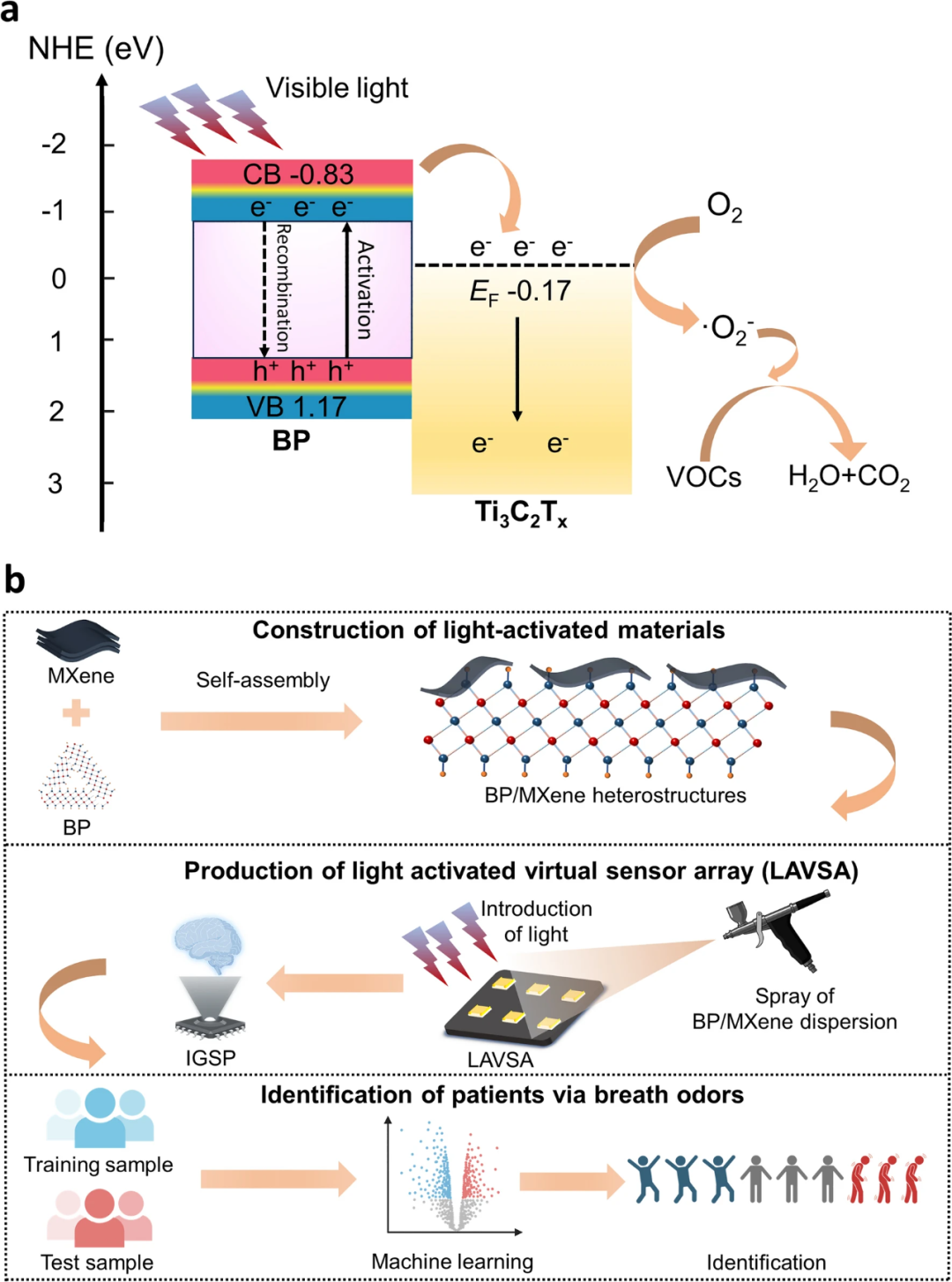 Figure 6. Mechanism of enhanced sensing performance of IGSPVI ConclusionIn conclusion, the aim of this study was to establish LAVSA and IGSP for non-invasive diagnosis of CHD through human odor identification. In this work, from the perspective of light modulation, BP was screened from materials with overlapping light absorption ranges with MXene, and the BP/Ti₃C₂Tₓ composite was synthesized using a MXene self-assembly strategy. As a proof of concept, the sensors were manufactured using BP/Ti₃C₂Tₓ and tested for gases such as ammonia, acetone, ethanol, and ether to determine the optimal values of light wavelength and intensity, as well as material ratios. Due to the synergistic effect of BP and MXene and photon excitation, the composite exhibited higher gas sensitivity performance, with responses under light being 26% higher than those in the absence of light, and selectivity was also improved. Based on this, LAVSA materials were prepared using three different ratios of BP/Ti₃C₂Tₓ and tested under light and dark conditions for 15 odor molecules. With the assistance of PCA and t-SNE pattern recognition algorithms, successful identification and classification of different gases were achieved, demonstrating its selectivity. Finally, the IGSP based on LAVSA and Arduino platform was put into practical use, and 45 volunteers were selected for testing, including healthy individuals and three different degrees of CAS patients. With the help of machine learning algorithms, the IGSP achieved identification accuracies of 77%, 71%, 58%, and 84% for H, CAS-1, CAS-2, and CAS-3, respectively, demonstrating good identification performance among CAS patients and healthy individuals.
Figure 6. Mechanism of enhanced sensing performance of IGSPVI ConclusionIn conclusion, the aim of this study was to establish LAVSA and IGSP for non-invasive diagnosis of CHD through human odor identification. In this work, from the perspective of light modulation, BP was screened from materials with overlapping light absorption ranges with MXene, and the BP/Ti₃C₂Tₓ composite was synthesized using a MXene self-assembly strategy. As a proof of concept, the sensors were manufactured using BP/Ti₃C₂Tₓ and tested for gases such as ammonia, acetone, ethanol, and ether to determine the optimal values of light wavelength and intensity, as well as material ratios. Due to the synergistic effect of BP and MXene and photon excitation, the composite exhibited higher gas sensitivity performance, with responses under light being 26% higher than those in the absence of light, and selectivity was also improved. Based on this, LAVSA materials were prepared using three different ratios of BP/Ti₃C₂Tₓ and tested under light and dark conditions for 15 odor molecules. With the assistance of PCA and t-SNE pattern recognition algorithms, successful identification and classification of different gases were achieved, demonstrating its selectivity. Finally, the IGSP based on LAVSA and Arduino platform was put into practical use, and 45 volunteers were selected for testing, including healthy individuals and three different degrees of CAS patients. With the help of machine learning algorithms, the IGSP achieved identification accuracies of 77%, 71%, 58%, and 84% for H, CAS-1, CAS-2, and CAS-3, respectively, demonstrating good identification performance among CAS patients and healthy individuals.
Author Information
 Yuan Lu
Yuan Lu
Corresponding Author
Tsinghua University Associate Professor▍Research Areas
Artificial life, swarm intelligence, synthetic biology, molecular manufacturing, neural sensing.
▍Biography
In the past five years, published over 80 academic articles, applied for/authorized more than 20 invention patents, and authored or co-authored 7 Chinese and English scientific books. Served as the editor-in-chief of one international academic journal, associate editor of three international academic journals, and editorial board member of several journals. Recent research projects have been supported by the National Key R&D Program of China, National Natural Science Foundation, etc.; selected for the National Youth Talent Support Program, and awarded the “Hou Debang Chemical Science and Technology Youth Award” among others. For more details, please visit the research group website: www.LuGroup.net.
▍Email:[email protected]
 Ping Zhang
Ping Zhang
Corresponding Author
Tsinghua University Professor▍Research Areas
Diagnosis and treatment of arrhythmias and complex cardiovascular diseases, particularly in the prevention and treatment of cardiac sudden death and precision treatment of hereditary arrhythmias, as well as research on artificial intelligence in cardiovascular diseases.
▍Biography
Long-term professor at Tsinghua University, doctoral supervisor, deputy director of Beijing Tsinghua Changgung Hospital, director of the Cardiovascular Center, and deputy director of the Tsinghua University Institute of Smart Medical Research. In the past five years, published over 50 academic articles, served as a member and head of the Informatics Group of the Cardiovascular Disease Branch of the Chinese Medical Association, vice chairman of the Arrhythmia Branch of the Chinese Society of Biomedical Engineering, vice chairman of the Heart Failure Working Committee of the Chinese Physician Association, vice chairman of the Cardiovascular Disease Branch of the Cross-Strait Medical Technology Exchange Association, vice chairman of the Arrhythmia and Electrocardiology Branch of the Chinese Medical Promotion Association, and vice chairman of the Cardiovascular Disease Branch of the Beijing Medical Association. Served as associate editor of “ESC Cardiovascular”, and editorial board member of “Chinese Journal of Cardiovascular Diseases”, “Chinese Journal of Arrhythmia”, “Chinese Journal of Pacing and Electrophysiology”, “Chinese Journal of Heart Failure and Cardiomyopathy (Electronic Edition)”, “Clinical Electrocardiology”, “PACE”, and “Cardiology Discovery”. Received funding from the National Natural Science Foundation, National Key R&D Program, “12th Five-Year” Science and Technology Support Program, and 973 sub-projects. Has received several awards including the Natural Science Award from the Ministry of Education, Beijing Science and Technology Progress Award, Chinese Medical Science and Technology Award, and Huaxia Medical Award, and has been recognized as a “Good Doctor of the People”, “Bethune-style Good Doctor”, “Outstanding Contribution Award for Pacemakers in China”, and “21st Century Contribution Award for Electrocardiography in China”.
▍Email:[email protected]
Written by: Original authors
Edited by: Editorial Department of “Nano-Micro Letters (English)”
About Us
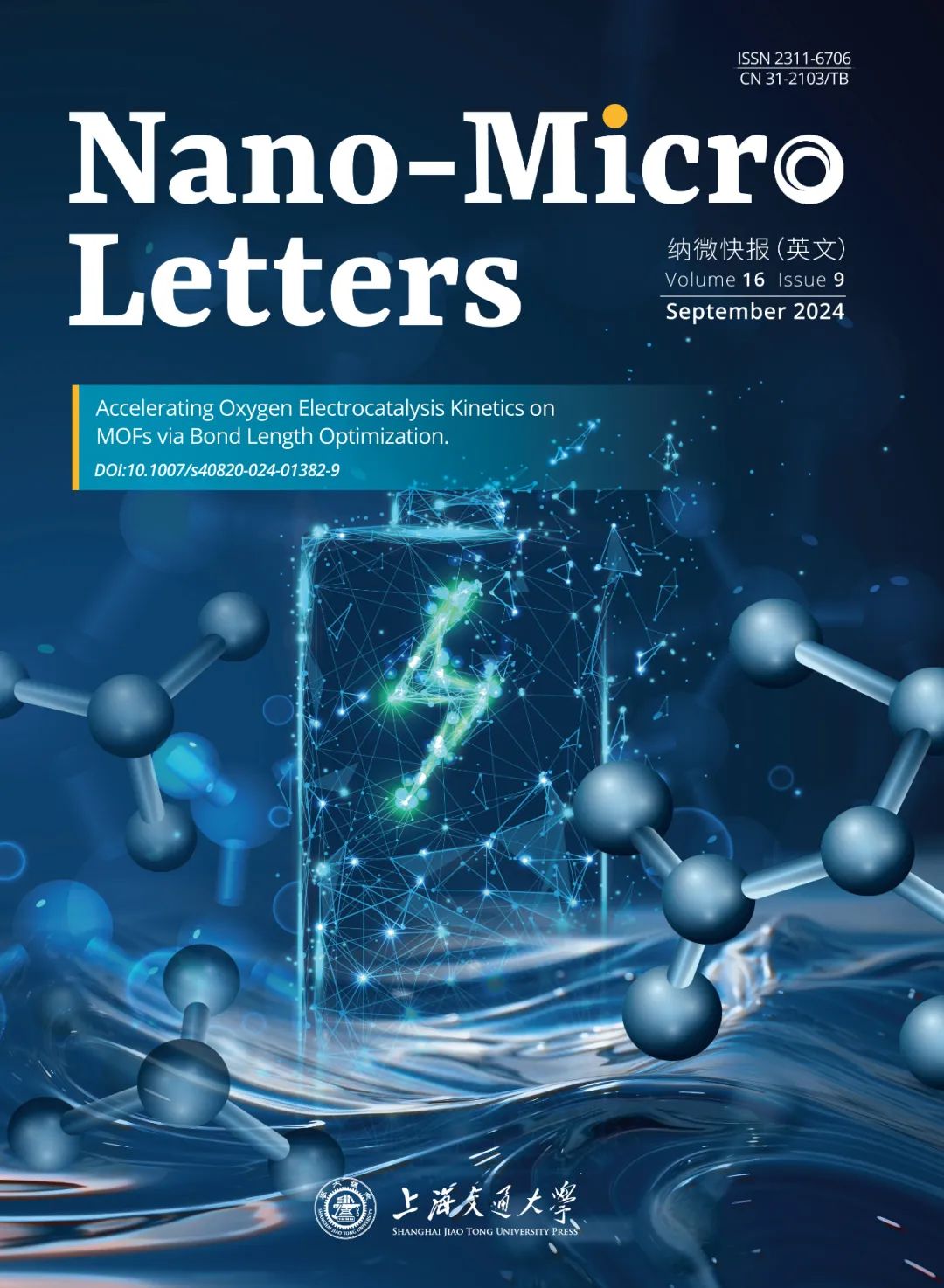 Nano-Micro Letters is an academic journal sponsored by Shanghai Jiao Tong University and published open-access by Springer Nature, primarily reporting high-level articles related to nano/micro-scale research, including synthesis, characterization, and performance of micro-nano materials and structures, as well as their applications in energy, catalysis, environment, sensing, electromagnetic wave absorption and shielding, and biomedicine. It has been indexed by SCI, EI, PubMed, SCOPUS, etc., with a 2023 impact factor of 31.6, ranking in the top 3% of Q1 journals in its field, and classified as a top-tier journal by the Chinese Academy of Sciences. It has received multiple honors including “China’s Most Internationally Influential Academic Journal”, “Outstanding Science and Technology Journal of Chinese Universities”, and “Shanghai Excellent Science and Technology Journal”, and was nominated for the “China Publishing Government Award Journal Award” in 2021. We welcome your attention and submissions.Web: https://springer.com/40820E-mail: [email protected]
Nano-Micro Letters is an academic journal sponsored by Shanghai Jiao Tong University and published open-access by Springer Nature, primarily reporting high-level articles related to nano/micro-scale research, including synthesis, characterization, and performance of micro-nano materials and structures, as well as their applications in energy, catalysis, environment, sensing, electromagnetic wave absorption and shielding, and biomedicine. It has been indexed by SCI, EI, PubMed, SCOPUS, etc., with a 2023 impact factor of 31.6, ranking in the top 3% of Q1 journals in its field, and classified as a top-tier journal by the Chinese Academy of Sciences. It has received multiple honors including “China’s Most Internationally Influential Academic Journal”, “Outstanding Science and Technology Journal of Chinese Universities”, and “Shanghai Excellent Science and Technology Journal”, and was nominated for the “China Publishing Government Award Journal Award” in 2021. We welcome your attention and submissions.Web: https://springer.com/40820E-mail: [email protected]
Tel: 021-34207624






Scan the QR code above to follow us
Click to read the original text/ Scan the mini-program code above to get the English original for free